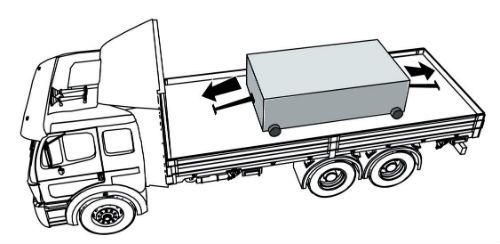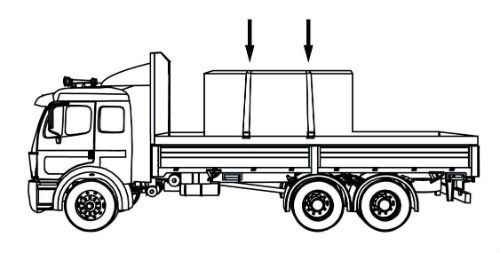CDL Practice Tests: Flatbed Cargo Securement
Choose A Section:
Go!Option #3 for securing metal coils transported with eyes lengthwise includes all of the following except:
- Using blocking or friction mats to prevent forward movement.
- Attaching at least one tiedown over the top of the coil near the rear of the coil.
- Attaching at least one tiedown over the top of the coil near the front of the coil.
- Attaching at least two tiedowns through the center of the coil.
Tiedowns, Single Coil Option #3
Option #3 is the same as Options #1 and #2, except that the two tiedowns that attach through the eye of the coil are replaced with two tiedowns that pass over the front and the rear of the coil.

Attach at least one tiedown over the top of the coil near the front of the coil.
Attach at least one tiedown over the top of the coil near the rear of the coil.
Use blocking or friction mats to prevent forward movement.
What is the minimum weight of a load of metal coils that requires specific securement practices?
- 5,000 lbs
- It depends on the size of the coils.
- 50,000 lbs
- 2,268 lbs
Size of coil
All metal coil shipments that, individually or together, weigh 2,268 kg (5,000 lb.) or more must be secured according to the specific requirements in this section.
Exception: Metal coils that weigh less than 2,268 kg (5,000 lb.) may be secured according to general securement requirements.
What is the minimum number of tiedowns to use on a load 4ft 7in long, and weighing 1,237 lbs?
- 2
- 3
- 4
- 1
-
If load is 5ft or shorter, 1,100 lbs or lighter:
Minimum number of tiedowns: 1
-
If load is 5ft or shorter, over 1,100 lbs:
Minimum number of tiedowns: 2
-
If load is more than 5ft but less than 10ft:
Minimum number of tiedowns: 2
Which of these is specifically prohibited when securing crushed or flattened vehicles?
- Containment walls.
- Chains.
- Synthetic webbing.
- Wire rope.
Securement Requirements
Transport flattened or crushed vehicles so that:
- Cargo does not shift while in transit AND
- Loose parts from the flattened vehicles do not dislodge and fall from the transport vehicle
Do not use synthetic webbing to secure vehicles.
What is the minimum nominal dimension of timber blocking used to secure concrete pipe?
- Half the diameter of the pipe
- 4 x 6 in
- 8 x 10 in
- 2 x 4 in
Blocking must be:
- Placed against the pipe
- Secured to prevent it from moving out from under the pipe.
Timber blocking must have a minimum nominal dimension of 10 x 15 cm (4 x 6 in).
A stack of shortwood loaded lengthwise can be secured with one tiedown if:
- They are blocked in the front by a headboard or another stack of logs.
- All of these apply.
- They are blocked in the back by the vehicle's end structure or another stack of logs.
- All logs in the stack are less than 10 ft long.
One tiedown
A stack can be secured with one tiedown if all logs in the stack less than 3.04 m (10 ft) are:
- Blocked in the front by a headboard strong enough to restrain the load or by another stack of logs.
- Blocked in the rear by the vehicle's end structure or another stack of logs.
What is the minimum WLL of a tiedown used to secure logs?
- 1,800 lb
- 50% of cargo weight
- 4,000 lb
- It depends on if you are hauling shortwood or longwood
- Use tiedowns in combination with bunks, stakes, or standards and bolsters to secure the load.
- All tiedowns must have a working load limit not less than 1,800 kg (4,000 lb.).
- Tension tiedowns as tightly as possible but not beyond their working load limit.
An anchor point is defined as:
- A rail along the side of a vehicle that protects the side of the vehicle from impacts.
- Part of the structure, fitting, or attachment on a vehicle or cargo to which a tiedown is attached.
- The load carrying area of a truck, trailer, or intermodal container.
- A vertical barrier across the front of the deck of a vehicle to prevent forward movement of cargo.
Anchor point:
Part of the structure, fitting, or attachment on a vehicle or cargo to which a tiedown is attached.
Requirements for securing a non-cubic shaped boulder with a stable base include all of the following except:
- Pass the tiedowns over the center of the boulder
- Attach chains together at the intersection
- Secure each boulder individually with at least two chain tiedowns forming an X pattern over the boulder.
- Wrap chains around the circumference of the boulder.

Secure each boulder individually with at least two chain tiedowns forming an X pattern over the boulder.
Pass the tiedowns over the center of the boulder and attach them to each other at the intersection by a shackle or other connecting device.
Define 'bolster':
- A crosswise load bearing structural component, particularly a part of a log bunk.
- A vertical barrier across the front of the deck of a vehicle to prevent forward movement of cargo.
- An inflatable bag intended to fill otherwise empty space between articles of cargo, or between articles of cargo and the wall of the vehicle.
- A structure, device, or another substantial article placed against or around an article to prevent horizontal movement of the article.
Bolster:
A crosswise load bearing structural component, particularly a part of a log bunk.
About The Flatbed Cargo Securement CDL Manual
Studying the flatbed cargo securement CDL manual is not a requirement for getting your CDL permit or license. It is required knowledge for flatbed drivers.
Some questions you should be able to answer for flatbed cargo securement:
- What is the minimum Working Load Limit of a tiedown used to secure logs?
- What is the minimum weight of a shipment of paper rolls that would require specific securement requirements?
- When securing concrete pipe over 45 inches loaded crosswise, which direction must the tiedowns on the front half of the load run?
- What is a cab shield?
- When securing concrete pipe over 45 inches loaded crosswise, which direction must the tiedowns on the rear half of the load run?
- What is a dunnage bag?
- Who is responsible for inspecting securing devices and cargo within the first 50 miles?
- How many tiedowns are required on a stack of shortwood loaded crosswise?
- What is the minimum working load limit of each tiedown used to secure crushed or flattened vehicles?
- Define 'bolster'
- What is a hook-lift container?
- When a tiedown is attached directly to the cargo, what is the ideal angle where it attached to the vehicle?
What is a securing device?
Any device specifically manufactured to attach or secure cargo to a vehicle or trailer:
- Synthetic Webbing
- Chain
- Wire rope
- Manila rope
- Synthetic rope
- Steel strapping
- Clamps and latches
- Blocking
- Front-end structure
- Grab hooks
- Binders
- Shackles
- Winches
- Stake pockets
- D-rings
- Webbing ratchet
- Bracing
- Friction mat
What is a tiedown?
A combination of securing devices that forms an assembly that:
- Attaches cargo to, or restrains cargo on a vehicle.
- Is attached to anchor point(s).

Some tiedowns are attached to the cargo and provide direct resistance to restrain the cargo from movement.

Some tie-downs pass over or through the cargo. They create a downward force that increases the effect of friction between the cargo and the deck. This friction restrains the cargo.
 Related Cargo Securement Terms That Every Driver Should Know:
Related Cargo Securement Terms That Every Driver Should Know:
-
Tiedown:
A combination of securing devices which form an assembly that attaches cargo to, or restrains cargo on, a vehicle or trailer, and is attached to anchor point(s).
-
Contained:
Cargo is contained if it fills a sided vehicle, and every article is in contact with or sufficiently close to a wall or other articles so that it cannot shift or tip if those other articles are also unable to shift or tip.
-
Blocking:
A structure, device, or another substantial article placed against or around an article to prevent horizontal movement of the article.
How should tiedowns be attached?
Tiedowns can be used in two ways:
-
Attached to the cargo:
- Tiedowns attached to the vehicle and attached to the cargo.
- Tiedowns attached to the vehicle, pass through or aroundan article of cargo, and then are attached to the vehicle again.
-
Pass over the cargo:
- Tiedowns attached to the vehicle, passed over the cargo, and then attached to the vehicle again.
Tiedown placement:

Place the tiedown as close as possible to the spacer.
Position the tiedowns as symetrically as possible over the length of the article.

Position the tiedowns to preserve the integrity of the article.







 TT On Facebook
TT On Facebook